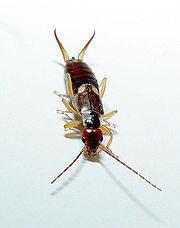
Cercus
Encyclopedia


Appendage
In invertebrate biology, an appendage is an external body part, or natural prolongation, that protrudes from an organism's body . It is a general term that covers any of the homologous body parts that may extend from a body segment...
s on the rear-most segments of many arthropod
Arthropod
An arthropod is an invertebrate animal having an exoskeleton , a segmented body, and jointed appendages. Arthropods are members of the phylum Arthropoda , and include the insects, arachnids, crustaceans, and others...
s, including insect
Insect
Insects are a class of living creatures within the arthropods that have a chitinous exoskeleton, a three-part body , three pairs of jointed legs, compound eyes, and two antennae...
s and arachnid
Arachnid
Arachnids are a class of joint-legged invertebrate animals in the subphylum Chelicerata. All arachnids have eight legs, although in some species the front pair may convert to a sensory function. The term is derived from the Greek words , meaning "spider".Almost all extant arachnids are terrestrial...
s but not crustacean
Crustacean
Crustaceans form a very large group of arthropods, usually treated as a subphylum, which includes such familiar animals as crabs, lobsters, crayfish, shrimp, krill and barnacles. The 50,000 described species range in size from Stygotantulus stocki at , to the Japanese spider crab with a leg span...
s. Cerci often serve as sensory organs, but they may also be used as weapons or copulation aids, or they may simply be vestigial structure
Vestigial structure
Vestigiality describes homologous characters of organisms that have seemingly lost all or most of their original function in a species through evolution. These may take various forms such as anatomical structures, behaviors and biochemical pathways. Some of these disappear early in embryonic...
s.
Typical cerci may appear to be jointed and hair-like, but they can take very different forms. Earwig
Earwig
Earwigs make up the insect order Dermaptera, found throughout the Americas, Africa, Eurasia, Australia and New Zealand. With 1,800 species in 12 families, they are one of the smaller insect orders...
s and some diplurans have large, stout pincer-like cerci. Crickets
Cricket (insect)
Crickets, family Gryllidae , are insects somewhat related to grasshoppers, and more closely related to katydids or bush crickets . They have somewhat flattened bodies and long antennae. There are about 900 species of crickets...
have particularly long cerci while other insects have cerci that are too small to be noticeable. Some insects such as mayflies have an accompanying third tail filament which extends from the tip of the abdomen
Abdomen
In vertebrates such as mammals the abdomen constitutes the part of the body between the thorax and pelvis. The region enclosed by the abdomen is termed the abdominal cavity...
. Aphid
Aphid
Aphids, also known as plant lice and in Britain and the Commonwealth as greenflies, blackflies or whiteflies, are small sap sucking insects, and members of the superfamily Aphidoidea. Aphids are among the most destructive insect pests on cultivated plants in temperate regions...
s have tube-like cornicle
Cornicle
The cornicle is one of a pair of small upright backward-pointing tubes found on the dorsal side of the last segment of the bodies of aphids. They are sometimes mistaken for cerci...
s or siphunculi that are sometimes mistaken for cerci.
Like a surprising number of insect body parts, including mandibles
Mandible (insect)
Insect mandibles are a pair of appendages near the insect’s mouth, and the most anterior of the three pairs of oral appendages . Their function is typically to grasp, crush, or cut the insect’s food, or to defend against predators or rivals...
and antennae
Antenna (biology)
Antennae in biology have historically been paired appendages used for sensing in arthropods. More recently, the term has also been applied to cilium structures present in most cell types of eukaryotes....
, cerci are thought to have evolved from what were legs
Arthropod leg
The arthropod leg is a form of jointed appendage of arthropods, usually used for walking. Many of the terms used for arthropod leg segments are of Latin origin, and may be confused with terms for bones: coxa , trochanter , femur, tibia, tarsus, ischium, metatarsus, carpus, dactylus ,...
on the primal insect form; a creature not unlike a caterpillar
Caterpillar
Caterpillars are the larval form of members of the order Lepidoptera . They are mostly herbivorous in food habit, although some species are insectivorous. Caterpillars are voracious feeders and many of them are considered to be pests in agriculture...
, velvet worm
Velvet worm
The velvet worms are a minor ecdysozoan phylum. These obscurely segmented organisms have tiny eyes, antennae, multiple pairs of legs and slime glands. They have variously been compared to worms with legs, caterpillars and slugs...
, or centipede
Centipede
Centipedes are arthropods belonging to the class Chilopoda of the subphylum Myriapoda. They are elongated metameric animals with one pair of legs per body segment. Despite the name, centipedes can have a varying number of legs from under 20 to over 300. Centipedes have an odd number of pairs of...
, worm-like with many pairs of legs, one for each segment
Segmentation (biology)
Segmentation in biology refers to either a type of gastrointestinal motility or the division of some animal and plant body plans into a series of repetitive segments. This article will focus on the segmentation of animal body plans, specifically using the examples of the phyla Arthropoda,...
.

